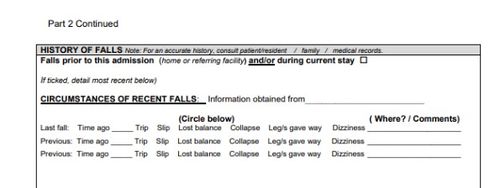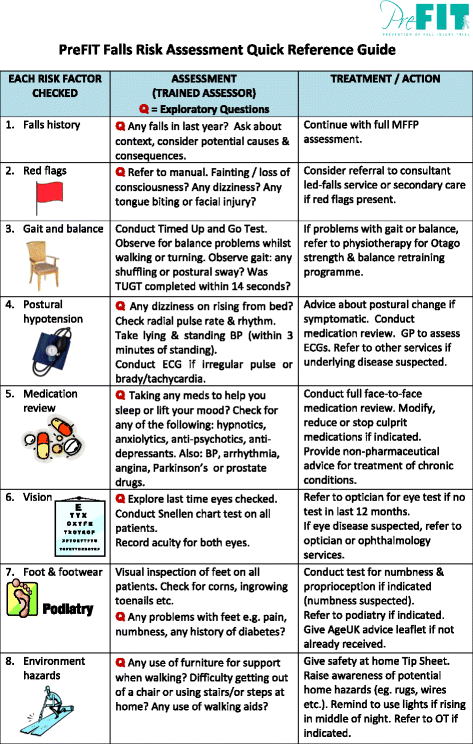Some Of Dementia Fall Risk
Table of ContentsSome Known Details About Dementia Fall Risk Rumored Buzz on Dementia Fall RiskThe Basic Principles Of Dementia Fall Risk Fascination About Dementia Fall Risk
An autumn danger evaluation checks to see how most likely it is that you will fall. It is mostly provided for older adults. The assessment usually includes: This includes a series of inquiries regarding your total health and if you have actually had previous drops or issues with balance, standing, and/or strolling. These tools examine your stamina, balance, and stride (the method you walk).STEADI includes testing, assessing, and intervention. Interventions are recommendations that may reduce your danger of falling. STEADI consists of three actions: you for your risk of dropping for your danger aspects that can be improved to try to avoid falls (as an example, equilibrium issues, damaged vision) to decrease your threat of falling by making use of effective techniques (as an example, providing education and learning and sources), you may be asked a number of inquiries including: Have you fallen in the previous year? Do you really feel unsteady when standing or walking? Are you stressed over falling?, your service provider will certainly test your stamina, equilibrium, and stride, using the adhering to fall evaluation tools: This examination checks your stride.
Then you'll sit down once again. Your provider will certainly examine for how long it takes you to do this. If it takes you 12 seconds or more, it might mean you are at higher risk for a fall. This test checks strength and balance. You'll being in a chair with your arms went across over your chest.
Relocate one foot halfway forward, so the instep is touching the big toe of your various other foot. Relocate one foot totally in front of the various other, so the toes are touching the heel of your other foot.
Examine This Report about Dementia Fall Risk
The majority of falls happen as a result of numerous adding elements; therefore, taking care of the danger of falling starts with determining the factors that add to fall threat - Dementia Fall Risk. Several of one of the most relevant threat elements consist of: History of prior fallsChronic medical conditionsAcute illnessImpaired stride and equilibrium, lower extremity weaknessCognitive impairmentChanges in visionCertain risky medications and polypharmacyEnvironmental factors can likewise increase the danger for drops, including: Poor lightingUneven or harmed flooringWet or slippery floorsMissing or harmed handrails and order barsDamaged or incorrectly equipped devices, such as beds, mobility devices, or walkersImproper use assistive devicesInadequate guidance of individuals residing in the NF, consisting of those who display hostile behaviorsA effective fall threat management program calls for a about his complete medical evaluation, with input from all participants of the interdisciplinary team

The treatment strategy must also consist of interventions that are system-based, such as those that advertise a risk-free setting (proper illumination, handrails, get hold of bars, etc). The performance of the interventions need to be examined occasionally, and the treatment plan changed as required to mirror modifications in the fall risk analysis. Carrying out a fall threat administration system making use of evidence-based finest practice can minimize the frequency of drops in the NF, while restricting the potential for fall-related injuries.
Dementia Fall Risk - An Overview
The AGS/BGS guideline suggests evaluating all grownups aged 65 years and older for loss danger each year. This testing consists of asking individuals whether they have actually fallen 2 or more times in the past year or sought clinical focus for a fall, or, if they have not fallen, whether they feel unsteady when strolling.
Individuals who have dropped when without injury should have their equilibrium and gait assessed; those with gait or equilibrium problems should obtain additional assessment. A history of 1 fall without injury and without gait or equilibrium issues does not necessitate further assessment beyond continued annual fall risk screening. Dementia Fall Risk. An autumn threat evaluation is needed as component of the Welcome to Medicare exam

Unknown Facts About Dementia Fall Risk
Recording a falls history is one of the quality indicators for loss avoidance and administration. Psychoactive drugs in certain are independent forecasters of falls.
Postural hypotension can usually be Click This Link eased by minimizing the dosage of blood pressurelowering drugs and/or stopping drugs that have orthostatic hypotension as an adverse effects. Use above-the-knee support hose and resting with the head of the bed raised might likewise lower postural reductions in high blood pressure. The advisable aspects of a fall-focused health examination are revealed in Box 1.

A TUG time more than or equal to 12 seconds recommends high autumn risk. The 30-Second Chair Stand examination evaluates reduced extremity stamina and balance. Being incapable to stand up from a chair of knee elevation without utilizing one's arms indicates enhanced loss risk. The 4-Stage Equilibrium examination examines static equilibrium by having the person stand in 4 placements, each progressively extra difficult.